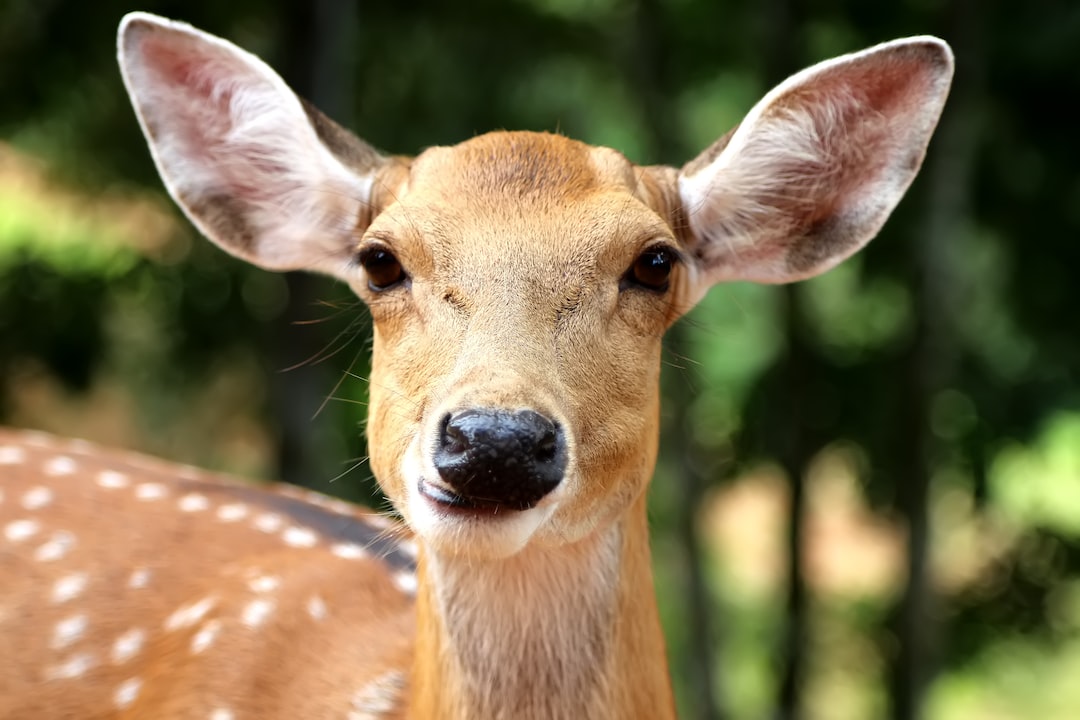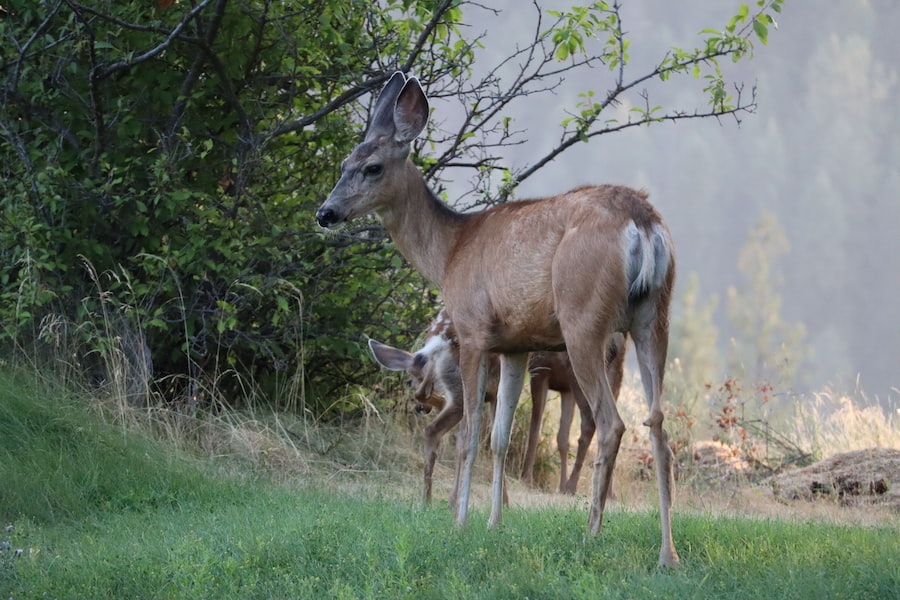Shielding Your Young Trees: Tips on Protecting Them from Deer Damage

Protecting young trees from deer damage is crucial for their growth and survival. Deer can cause significant harm to young trees by browsing on their foliage, rubbing their antlers against the trunks, and even uprooting them. This can lead to stunted growth, deformities, and even death of the trees. In this article, we will discuss the importance of protecting young trees from deer damage and provide tips on how to do so effectively.
Key Takeaways
- Protecting young trees from deer damage is important for their growth and survival.
- Signs of deer damage on young trees include stripped bark, broken branches, and missing leaves.
- Choosing the right tree species for deer-prone areas can help prevent damage.
- Physical barriers and deer repellents can be effective in keeping deer away from young trees.
- Creating a deer-resistant landscape design and regularly monitoring for damage can also help protect young trees.
Understanding the Importance of Protecting Young Trees from Deer Damage
Deer damage can have long-term effects on the growth and health of young trees. When deer browse on the foliage of young trees, they remove the leaves that are essential for photosynthesis. This reduces the tree’s ability to produce energy and grow. Additionally, deer can cause physical damage to the trunks of young trees by rubbing their antlers against them. This can create wounds that are susceptible to infection and disease.
Furthermore, deer can uproot young trees by digging around their roots in search of food. This can lead to the death of the tree if it is not replanted properly. Even if the tree survives, it may suffer from stunted growth and deformities due to the damage caused by the deer.
Identifying Signs of Deer Damage on Young Trees
It is important to be able to identify signs of deer damage on young trees early on so that appropriate measures can be taken to protect them. Common signs of deer damage include stripped bark, jagged or torn leaves, broken branches, and uprooted trees. Deer also leave behind tracks and droppings near damaged trees.
To identify deer damage early on, it is helpful to regularly inspect your young trees for any signs of browsing or physical damage. This can be done by visually inspecting the foliage, trunk, and branches of the trees. Additionally, setting up motion-activated cameras near your trees can help you monitor deer activity and identify any damage they may be causing.
Choosing the Right Tree Species to Plant in Deer-Prone Areas
| Tree Species | Deer Resistance | Growth Rate | Mature Height | Soil Type |
|---|---|---|---|---|
| White Oak | High | Slow | 60-100 ft | Well-drained |
| Red Maple | Medium | Fast | 40-60 ft | Moist |
| American Holly | High | Slow | 15-30 ft | Well-drained |
| Eastern Red Cedar | High | Slow | 40-50 ft | Well-drained |
| Black Walnut | High | Slow | 70-90 ft | Well-drained |
One way to minimize deer damage to young trees is by choosing tree species that are less susceptible to browsing. Some tree species, such as cedar, spruce, and holly, are naturally less appealing to deer due to their taste or texture. Planting these species in deer-prone areas can help deter deer from feeding on your young trees.
When selecting tree species for your area, it is important to consider the specific conditions of your site, such as soil type, sunlight exposure, and moisture levels. Consulting with a local arborist or nursery can help you choose the right tree species that are suitable for your area and less likely to be damaged by deer.
Installing Physical Barriers to Keep Deer Away from Young Trees
Physical barriers can be an effective way to keep deer away from young trees. There are several types of physical barriers that can be used, including fences, tree shelters, and netting.
Fences can be made from various materials such as wire mesh or plastic. They should be at least 8 feet tall to prevent deer from jumping over them. Tree shelters are plastic tubes that can be placed around the trunks of young trees to protect them from browsing and rubbing. Netting can be used to cover the foliage of young trees and prevent deer from reaching it.
When installing physical barriers, it is important to ensure that they are properly secured and provide adequate protection for the young trees. Fences should be buried at least 6 inches into the ground to prevent deer from digging under them. Tree shelters should be securely fastened around the trunks of the trees. Netting should be tightly secured around the foliage without causing any damage to the branches.
Using Deer Repellents to Deter Deer from Feeding on Young Trees

Deer repellents can be an effective tool for deterring deer from feeding on young trees. There are several types of deer repellents available, including chemical repellents, natural repellents, and noise deterrents.
Chemical repellents are typically sprayed onto the foliage of young trees and emit an odor that is unpleasant to deer. Natural repellents, such as predator urine or soap bars, can also be used to deter deer. Noise deterrents, such as motion-activated sprinklers or wind chimes, can startle deer and discourage them from approaching your young trees.
When using deer repellents, it is important to follow the instructions provided by the manufacturer and apply them regularly to ensure their effectiveness. It is also important to rotate between different types of repellents to prevent deer from becoming accustomed to a specific scent or noise.
Creating a Deer-Resistant Landscape Design to Protect Young Trees
Creating a deer-resistant landscape design can help deter deer from feeding on your young trees. This can be done by incorporating plants that are less appealing to deer, such as those with thorny or aromatic foliage. Additionally, creating physical barriers, such as hedges or rock walls, can help prevent deer from accessing your young trees.
When designing your landscape, it is important to consider the specific preferences and habits of deer in your area. Consulting with a local landscape designer or wildlife expert can help you create a landscape design that is effective in deterring deer.
Pruning Young Trees to Minimize Deer Damage
Pruning young trees can help minimize deer damage by removing lower branches that are within reach of browsing deer. By raising the canopy of the tree, you can make it more difficult for deer to reach the foliage and reduce the likelihood of browsing.
When pruning young trees, it is important to follow proper pruning techniques and avoid over-pruning. Removing too many branches can stress the tree and make it more susceptible to disease and pests. It is also important to prune at the right time of year, typically during the dormant season, to minimize the impact on tree growth.
Providing Adequate Water and Nutrients to Help Young Trees Recover from Deer Damage
Providing adequate water and nutrients can help young trees recover from deer damage and promote their growth and health. Watering young trees regularly, especially during dry periods, can help them recover from browsing and reduce stress. Applying a balanced fertilizer can also provide the necessary nutrients for tree growth and recovery.
When providing water and nutrients to young trees, it is important to follow proper watering and fertilizing techniques. Overwatering or over-fertilizing can be detrimental to tree health and lead to root rot or nutrient imbalances. It is also important to consider the specific needs of the tree species and adjust watering and fertilizing accordingly.
Monitoring Young Trees for Signs of Deer Damage Regularly
Regular monitoring of young trees is important to identify any signs of deer damage early on. By regularly inspecting your trees, you can take prompt action to protect them from further damage and ensure their long-term health.
Monitoring can be done by visually inspecting the foliage, trunk, and branches of the trees. Setting up motion-activated cameras near your trees can also help you monitor deer activity and identify any damage they may be causing.
Consulting with Experts to Develop an Effective Plan for Protecting Young Trees from Deer Damage
Consulting with experts, such as arborists or wildlife specialists, can be helpful in developing an effective plan for protecting young trees from deer damage. These professionals have the knowledge and experience to assess your specific situation and provide tailored recommendations for protecting your trees.
When consulting with experts, it is important to provide them with detailed information about your site, including the tree species, deer population, and specific challenges you are facing. This will help them develop a plan that is suitable for your needs and maximize the effectiveness of the measures taken.
Protecting young trees from deer damage is essential for their growth and survival. Deer can cause significant harm to young trees through browsing, rubbing, and uprooting. By understanding the importance of protecting young trees, identifying signs of deer damage, choosing the right tree species, installing physical barriers, using deer repellents, creating a deer-resistant landscape design, pruning effectively, providing adequate water and nutrients, monitoring regularly, and consulting with experts, you can effectively protect your young trees from deer damage and ensure their long-term health and beauty.



